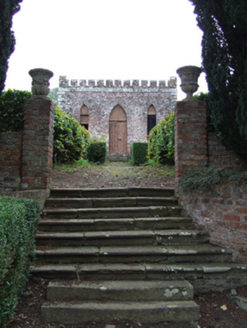Survey Data
Reg No
40401743
Rating
Regional
Categories of Special Interest
Archaeological, Architectural, Historical
Previous Name
Rakenny House
Original Use
Walled garden
In Use As
Walled garden
Date
1720 - 1740
Coordinates
254112, 311515
Date Recorded
03/08/2012
Date Updated
--/--/--
Description
Detached rectangular-plan three-bay single-storey tea house in Georgian Gothic style, built c.1730. Red brick walls with rusticated ashlar quoins and a battlemented parapet of brick merlons over a limestone platband. Tall lancet windows flanking central pointed arch doorway with timber battened tympanum over double-leaf doors with twin cusped pointed arched panels above short flight of limestone steps. Set between low quadrant walls terminating in urn-topped brick piers. Axially arranged terraced walled garden of earlier date, and approached by a metal footbridge on the central axis. Garden descends to river in three terraces terminating at a retaining quay wall level to the ground. Side walls descend to river with terminating octagonal ashlar piers with base at quay side having cornice and surmounting urn. Central path with flights of steps flanked by urn-topped brick piers and Irish yew trees rising to the summer house on the back wall of the garden. Located within Rathkenny Demesne on the opposite bank of the Annalee River to Rathkenny House.
Appraisal
A visitor in 1739 admired how the river at Rathkenny was ‘beautified by an elegant house, improvements and large plantations on the S shore, and on its N bank by extensive gardens and terraces’. While the rusticated quoins and plat band suggest that the tea house is of early Georgian date, the terraced gardens open to the river may retain elements of an earlier designed landscape, associated with an earlier Jacobean house. The Ordnance Survey map of 1836 records the foot bridge further to the west on a different alignment. It also records a ringfort east of the tea-house, indicating that this location was occupied at two different eras of the county’s history. A similar exotic garden landscape at nearby Ballyhaise survives only in a written description, making this intact formal demesne landscape all the more important.

